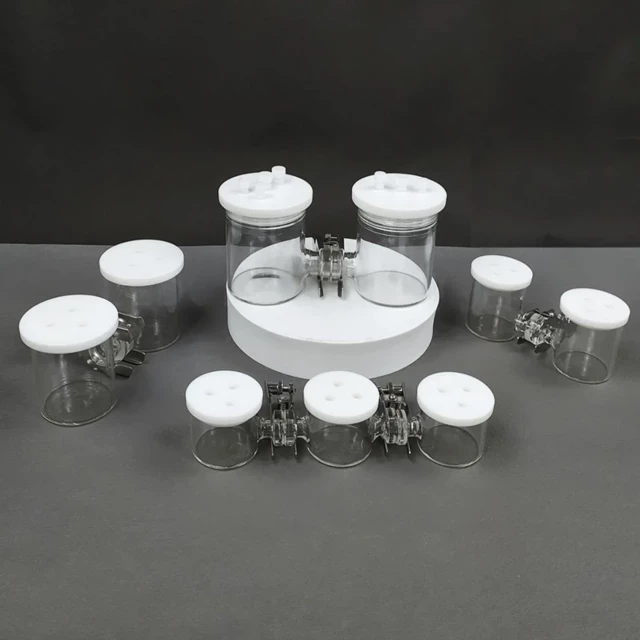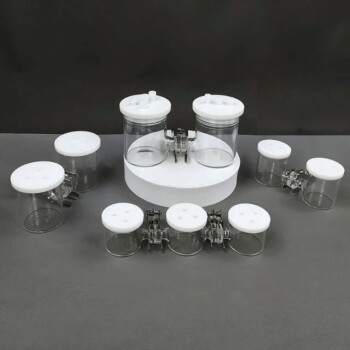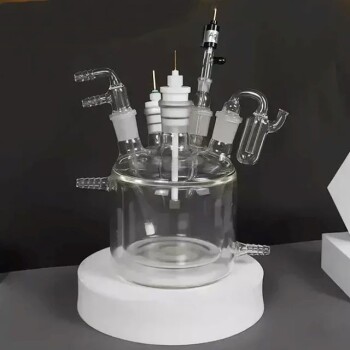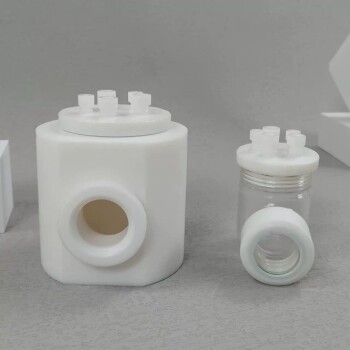Introduction to H-Type Electrolytic Cell
H-type electrolytic cells are widely used in the extraction of metals from their respective ores. This type of cell uses an electrolyte solution to dissolve the metal ions and an electric current to separate the metal ions from the solution. The H-type electrolytic cell is particularly useful for the extraction of metals that are highly reactive and cannot be extracted using traditional methods. The cell's design allows for efficient extraction, and the process is relatively inexpensive compared to other extraction methods. This makes the H-type electrolytic cell a popular choice for metal extraction in various industries.
Table of Contents
Metal Extraction Using H-Type Electrolytic Cell
The H-Type Electrolytic Cell is a widely used technique to extract metals from their ores. This technique is particularly useful in the extraction of metals such as gold, silver, and copper from low-grade ores, which are more difficult to extract using conventional methods.

The process of metal extraction using H-Type Electrolytic Cell involves several steps. Firstly, the ore is crushed and ground into small particles. Then, it is mixed with a solution of the metal salt, which acts as an electrolyte.
In the next step, the anode and cathode are made of the same metal and placed in the electrolyte solution. When an electric current is passed through the electrolyte, the metal ions move towards the cathode and are deposited onto it. Meanwhile, the metal at the anode is oxidized and dissolves into the electrolyte solution, producing metal ions.
The deposited metal on the cathode is then removed and further refined using electrolysis, resulting in a high purity of the metal obtained from the ore. The process is also highly efficient, with a high yield of metal obtained from the ore.
The H-Type Electrolytic Cell is particularly useful in the extraction of copper. In the case of copper extraction, the electrolyte used is typically a solution of copper sulfate. The anode and cathode are made of the same metal, which is copper. When an electric current is passed through the electrolyte, the copper ions move towards the cathode and are deposited onto it, while the copper at the anode is oxidized and dissolves into the electrolyte solution, producing copper ions.
In conclusion, the H-Type Electrolytic Cell is an important tool in the field of metal extraction. It is a highly efficient and environmentally friendly method of extracting metals from their ores, particularly low-grade ores. With its versatility and effectiveness in the extraction of metals, the H-Type Electrolytic Cell is likely to continue to be an important tool in the extraction of metals in the future.
Extraction of Copper using H-Type Electrolytic Cell
Copper extraction using H-type electrolytic cell is a popular and efficient method due to its cost-effectiveness and high yield. The process involves several steps, which are as follows:
Crushing and Grinding
The copper ore is first crushed and ground to a fine powder to increase the surface area of the ore particles for better reaction rates.
Mixing with Water and Sulfuric Acid
The crushed copper ore is then mixed with water and sulfuric acid to prepare the solution for the electrolytic cell.
H-Type Electrolytic Cell
The prepared solution is fed into the H-type electrolytic cell, which consists of a cathode and an anode separated by a semi-permeable membrane. An electric current is then passed through the solution.
Deposition of Copper Ions
During the electrolysis process, copper ions in the solution are attracted to the cathode and deposited onto it, forming a layer of pure copper. This process continues until all the copper ions have been deposited onto the cathode.
Reduction of Sulfuric Acid
At the anode, sulfuric acid is reduced to hydrogen gas. The hydrogen gas is released into the atmosphere, leaving behind the pure copper.
Collection of Final Product
The final product, which is pure copper, is then collected and used for various applications, such as electrical wiring and plumbing.
In conclusion, the H-type electrolytic cell is an efficient and cost-effective method of copper extraction. It uses electricity rather than chemicals to separate the desired metal from the ore, making it an environmentally friendly method of metal extraction. Overall, the H-type electrolytic cell is a valuable tool in the field of laboratory equipment, particularly in the extraction of metals such as copper.
Extraction of Aluminum using H-Type Electrolytic Cell
The extraction of aluminum using the H-Type Electrolytic Cell involves several steps, which are explained below.

Step 1: Preparation of the Anode and Cathode
The H-Type Electrolytic Cell consists of a cathode and an anode, both immersed in an electrolyte. The anode is made of carbon, while the cathode is made of carbon or graphite. These materials are chosen because they are good conductors of electricity and are resistant to the high temperatures needed in the process.
Step 2: Dissolving the Alumina in the Electrolyte
The alumina is dissolved in a liquid electrolyte, which is usually a mixture of molten cryolite and aluminum fluoride. This electrolyte has a low melting point, which helps to reduce the energy required for the process.
Step 3: Heating the Cell
The cell is heated to a temperature of about 960°C, which is necessary to keep the electrolyte in a liquid state and to facilitate the movement of the aluminum ions.
Step 4: Passing Electrical Current through the Cell
The electrical current is then passed through the cell, which causes the aluminum ions to move towards the cathode, where they are reduced to form metallic aluminum. The cathode also acts as a collector for the metallic aluminum, which is then drained to a crucible.
Step 5: Mechanism of Aluminum Extraction
During the process, the aluminum ions in the electrolyte are attracted to the cathode, where they gain electrons and are reduced to form metallic aluminum. At the same time, oxygen ions are produced at the anode, where they combine with the carbon in the anode to form carbon dioxide gas. The overall reaction can be represented as follows:
2Al2O3 + 3C → 4Al + 3CO2
Step 6: Advantages of the H-Type Electrolytic Cell
The H-Type Electrolytic Cell is preferred for the extraction of aluminum because it is efficient, cost-effective, and produces high purity aluminum. The electrolyte used in the cell is reusable, which reduces the cost of the process. The cell also produces oxygen and carbon dioxide as by-products, which can be used in other industrial processes.
In conclusion, the H-Type Electrolytic Cell has revolutionized the process of aluminum extraction, making it more efficient, cost-effective, and environmentally friendly. The production of high-purity aluminum is vital in industries such as aerospace, construction, and automotive, and the H-Type Electrolytic Cell has made this achievable.
Advantages of using H-Type Electrolytic Cell
The H-Type electrolytic cell is widely used in the metal extraction industry due to its numerous advantages over conventional electrolytic cells. In this section, we will explore the advantages of using H-Type Electrolytic Cells in metal extraction.
Lower energy requirements
One of the primary advantages of using H-Type electrolytic cells is that they require less energy to operate, making them more cost-effective than other types of cells. The H-Type electrolytic cell has a unique design that allows for the efficient production of metals like aluminum, magnesium, and titanium.
High-purity metals
Additionally, these cells produce high-purity metals that are free from impurities, which reduces the need for costly purification processes. This is achieved because the H-Type electrolytic cell allows for the selective extraction of metals, which means that only the desired metal is extracted, reducing waste and increasing efficiency.
Longer lifespan and easy maintenance
Another significant advantage of using H-Type electrolytic cells is that they have a longer lifespan than other cells, reducing the need for frequent replacement. The design of the cell also allows for easy maintenance and cleaning, which further reduces downtime and maintenance costs.
Better efficiency
The H-Type electrolytic cell is also known for its better efficiency compared to other cells. This is due to the unique design of the cell which allows it to achieve higher production rates and yields compared to other cells.
In summary, the H-Type electrolytic cell is a highly efficient and cost-effective tool for metal extraction that is widely used in the industry today. Its numerous advantages make it a valuable asset in the production of high-quality metals while reducing costs and increasing efficiency.
Conclusion
H-Type Electrolytic Cell has proven to be an efficient and cost-effective method for metal extraction. Its ability to extract metals with high purity and yield makes it an attractive option for the industry. Copper and aluminum extraction using H-Type Electrolytic Cell have been successful and are widely used in the manufacturing of various products. The advantages of using this technology include low operating costs, high efficiency, and environmental friendliness. As the demand for metals continues to rise, H-Type Electrolytic Cell will undoubtedly play a significant role in meeting this demand while minimizing the impact on the environment.
Related Products
- H Type Electrolytic Cell Triple Electrochemical Cell
- H-Type Double-Layer Optical Electrolytic Electrochemical Cell with Water Bath
- Thin-Layer Spectral Electrolysis Electrochemical Cell
- Multifunctional Electrolytic Electrochemical Cell Water Bath Single Layer Double Layer
- Electrolytic Electrochemical Cell for Coating Evaluation
Related Articles
- The Silent Variable: Engineering Reliability in Electrolytic Cells
- Applications of Electrolytic Cells in Purification and Electroplating
- Overcoming Challenges with H-Type Electrolytic Cell Operation
- The Art of the Non-Spontaneous: Precision in Electrolytic Circuits
- Understanding Electrodes and Electrochemical Cells














